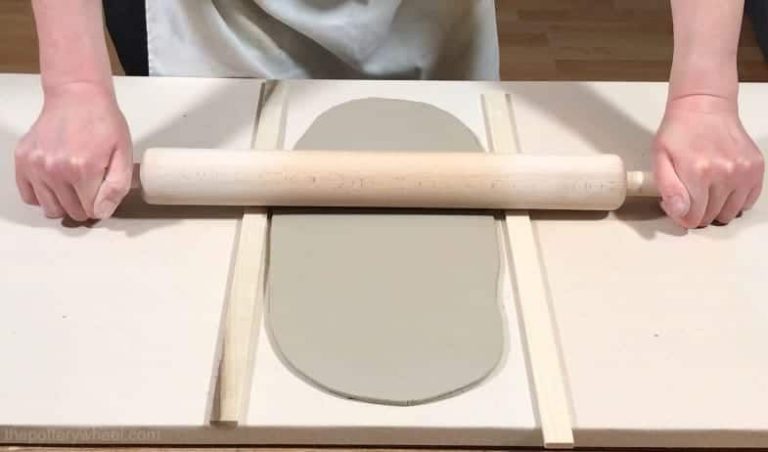What Is Wheel Throwing?
Wheel throwing is a process where a ball of clay is centered on a rotating pottery wheel and shaped using your hands as it spins. It is one of the most common methods of creating pottery and ceramic vessels. Wheel throwing dates back thousands of years, with the earliest known examples found in China dating back to around 3500 BCE (http://swfineart.weebly.com/throwing1.html). However, it likely originated even earlier.
The basic wheel throwing process involves centering a lump of clay on the wheel, opening up the form to create the interior space, shaping the walls and refining the rim, then allowing it to partially dry before additional smoothing and trimming to finish the final vessel shape. After drying to a leather-hard state, the pottery is fired in a kiln to permanently harden the clay. Glazes and decoration can also be added before a final firing.

Wheel throwing requires practice to master the techniques of centering, opening, raising, and shaping the clay. However, it allows potters to efficiently create a wide variety of round vessels with thinner walls and uniform shapes. The rotation of the wheel also lends itself to creating beautiful symmetrical forms.
Wheel Throwing Tools
The essential tools needed for wheel throwing include:
Potter’s Wheel – This spinning device is the most important tool for wheel throwing. The centrifugal force it generates allows the clay to be shaped into symmetrical forms. Modern wheels are powered by electricity, but traditional kick wheels are operated by foot pedals. Quality wheels have variable speed controls and smooth, wobble-free heads. Popular brands include Brent, Shimpo and Speedball (Rovin Ceramics).
Clay – A good quality clay that is plastic enough to bend and stretch without cracking is required. Porcelain and stoneware clays are common choices as they can withstand the high temperatures needed for firing finished pieces. The clay consistency should not be too wet or too dry for throwing.
Throwing tools – Ribbons, ribs, loop tools, trimming tools and sponges help shape, refine and smooth the clay on the spinning wheel. Steel, rubber and wood varieties assist the potter during different stages of throwing and finishing (Essential Tools for Wheel Throwing).
Preparing the Clay
One of the most important steps before throwing any pots is properly preparing the clay. This involves wedging and centering the clay on the wheel.
Wedging is the process of cutting and kneading the clay to distribute moisture evenly and remove any air pockets. According to The Clay Teacher’s demonstration video, wedging involves cutting the clay into four sections, stacking it into a loaf, then pushing and folding it together [1]. Proper wedging ensures the clay has an even consistency and avoids cracks or explosions during throwing or firing.
After wedging, the clay must be centered on the pottery wheel. Centering involves placing a clay ball in the middle of the wheel and applying even pressure while kicking the wheel to spin. As described on Pinterest, the goal is to form the clay into a symmetrical cone shape with rounded edges [2]. Well-centered clay allows the walls and base to be evenly pulled up during throwing.
Opening the Clay
Once the clay is centered on the potter’s wheel, the next step is to open up the solid lump into a hollow form with uniform walls. This process is referred to as “coning up” the clay. According to the YouTube tutorial “Opening Clay on Potter’s Wheel”, the potter starts by placing one hand inside the clay and one hand on the outside, applying gentle outward pressure to form the clay into a cone shape. As the wheel spins at a steady speed, the potter uses their fingers to gradually pull the clay upward and outward, creating a cavity in the center while the walls stretch taller. The key is to work slowly and methodically, applying even pressure on both sides to raise the walls to the desired height without thinning them out too much. As the tutorial states, it’s important to keep the walls an even thickness by frequently measuring with your hands. The end goal is to open up the clay into a symmetrical cone with uniform walls thick enough to support the final form.
Source: https://www.youtube.com/watch?v=Gi9xoU9IkAM
Raising the Walls
Once the clay has been centered on the wheel and opened up, it’s time to pull up the walls. This process begins by placing both hands on the outside of the clay mound and applying gentle outward pressure as the wheel spins. Using the centrifugal force generated by the spinning wheel, slowly pull the clay up and away from the center. Work gradually and patiently to raise the walls evenly. Avoid pulling too quickly or applying too much pressure, as this can cause the walls to be uneven or too thin.
As the walls are formed, use a metal rib tool to shape and refine them. Hold the rib against the outside of the rotating walls at an angle and gently move it up and down to compress and smooth the clay. The rib tool helps remove any lumps, grooves, or uneven sections. It also thins and evens out the walls. When raising the walls, aim to pull them up higher than the desired finished height. The upper section will be trimmed later to create an even rim. With practice and patience, you’ll be able to center the clay and raise the walls to create a symmetrical interior shape for any vessel or pot you wish to throw on the wheel.
Forming the Base
As the walls are raised, it’s important to compress and stabilize the base. Using one hand inside the emerging pot and the other outside, gently press down to form the bottom into a uniform thickness and density. This compression strengthens the clay and minimizes the risk of cracking or collapsing as you continue throwing. Keep the walls an even thickness by maintaining the gap between your hands as you shape the clay. Avoid thinning out the base excessively. Refer to advanced wheel throwing resources like The Crucible’s guide for more techniques on properly compressing clay.
Continue to periodically compress the base as you raise and shape the walls. This ensures sturdiness and stability in the finished piece. An uneven or inadequately compressed base makes the pot prone to warping or cracking during drying and firing. Take care not to over-compress, as this can also lead to cracking. Find the right balance through practice and experimentation.
Shaping the Rim
Once the basic shape of the pottery piece is formed, it’s time to refine the rim. This process is called “collaring in the rim” and involves using your fingers, a rib, and a sponge to shape the rim into its final form (https://www.thestudiomanager.com/posts/making-a-wide-rim-bowl-pottery-tutorial).
Start by wetting your hands and using your fingers to gently compress the clay at the rim. Apply even pressure while slowly rotating the wheel to form a rounded lip. Next, use a rib tool to further define the shape by scraping along the interior and exterior of the rim. The rib helps smooth out any unevenness.
After using the rib, take a damp sponge and use a light touch to refine the rim shape. The sponge will round and soften the rim while removing any scratches left by the rib. Pay close attention to creating an even thickness and smooth surface. Collaring in the rim takes practice, so don’t worry if it takes a few tries to get the shape just right.
The final rim shape possibilities are endless – from wide and flat, to rounded, to flared. Getting comfortable collaring in various rim shapes and profiles is an essential pottery wheel skill for creating unique and artistic pieces.
Trimming and Refining
Once the basic shape of the pot has been formed, the next step is trimming and refining the final product. This involves several techniques to smooth surfaces, refine the shape, and add decorative details.
Trimming tools like loop tools, ribs, and metal scrapers are used to carefully scrape and smooth the clay surface. The potter trims away any uneven edges or excess clay. This helps create thinner, more delicate walls and a refined shape. Using a moist sponge, the potter can also smooth and even out surfaces. Ribs and metal tools need to be used gently to avoid tearing the clay.
As the potter trims, they can refine the final shape, accentuating curves or subtleties in form. Decorative elements like grooves, indentions or pierced patterns can be carved into the clay. The potter may choose to alter the lip or foot of the piece for aesthetic effect. Trimming and refining transforms the basic thrown form into a finished work.
The trimming process requires patience and precision. Too much pressure can destroy the pot’s shape or structure. A keen eye and gentle touch help create the desired thinness, smoothness, and form. Trimming completes the wheel throwing process by elevating a simple pot into a refined work of art (https://www.lakesidepottery.com/Pages/Pottery-tips/Trimming-a-pot-Lakeside-Pottery-Tutorial.htm).
Drying and Firing
After shaping your pottery on the wheel, it’s crucial to allow it to dry fully before firing. As clay dries, water evaporates which causes the clay particles to bond together. Uneven drying can cause cracks or warping. To dry pottery evenly, place pieces upside down on plywood lined with newspaper, avoiding direct sunlight and drafts. Use plastic sheeting to trap moisture. Drying time depends on factors like climate, clay thickness, and composition but can take several days to weeks (https://ceramicartsnetwork.org/daily/article/Protecting-Your-Pottery-and-Ceramic-Sculpture-Hints-for-Even-Drying).
Firing pottery involves heating the clay to high temperatures which permanently hardens it through sintering. Firing is done in two main stages. The first is bisque firing which converts clay into a porous, brittle ceramic by heating to around 1800°F. Bisque firing prepares the clay for glazing and the final firing. The second stage is glost firing which fuses glaze onto the bisqueware surface, creating a glassy coating. Glost firing reaches over 2200°F. Kilns allow controlled heating and cooling during firing. Understanding the complete drying and firing process helps create lasting pottery pieces.
Conclusion
Wheel throwing is an ancient and global art form that requires patience, practice, and creativity. The process involves centering the clay on a pottery wheel, opening up the form, raising the walls, shaping the base and rim, then refining and trimming the final piece before drying and firing. While the steps may seem simple, it takes a skilled hand and artistic eye to create functional and beautiful ceramic vessels using this technique.
The magic of wheel throwing is seeing a lump of clay transformed into an elegant object. It combines the artistry of sculpting with the precision of working on a spinning wheel. Mastering wheel throwing allows artists to make one-of-a-kind pots and express their creativity through ceramics. Though it demands dedication to learn, wheel throwing is an incredibly satisfying and meditative practice. The finished wares reflect the potter’s individual style and connection between the hand, the clay, and the wheel.



